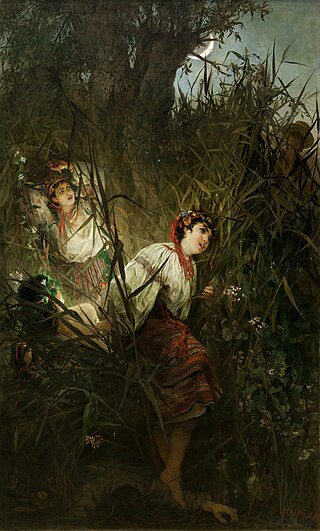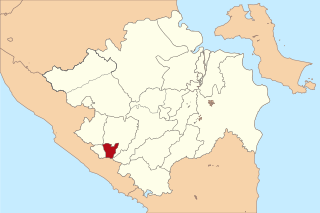Related Research Articles

A creation myth or cosmogonic myth is a type of cosmogony, a symbolic narrative of how the world began and how people first came to inhabit it. While in popular usage the term myth often refers to false or fanciful stories, members of cultures often ascribe varying degrees of truth to their creation myths. In the society in which it is told, a creation myth is usually regarded as conveying profound truths – metaphorically, symbolically, historically, or literally. They are commonly, although not always, considered cosmogonical myths – that is, they describe the ordering of the cosmos from a state of chaos or amorphousness.

Minangkabau people, also known as Minang, are an Austronesian ethnic group native to the Minangkabau Highlands of West Sumatra, Indonesia. The Minangkabau's West Sumatera homelands was the seat of the Pagaruyung Kingdom, believed by early historians to have been the cradle of the Malay race, and the location of the Padri War.

The Indigenous peoples of the Americas comprise numerous different cultures. Each has its own mythologies, many of which share certain themes across cultural boundaries. In North American mythologies, common themes include a close relation to nature and animals as well as belief in a Great Spirit that is conceived of in various ways. As anthropologists note, their great creation myths and sacred oral tradition in whole are comparable to the Christian Bible and scriptures of other major religions.
Finnish mythology commonly refers of the folklore of Finnish paganism, of which a modern revival is practiced by a small percentage of the Finnish people. It has many shared features with Estonian and other Finnic mythologies, but also with neighbouring Baltic, Slavic and, to a lesser extent, Norse mythologies.

Sun Wukong, also known as the Monkey King, is a literary and religious figure best known as one of the main characters in the 16th century Chinese novel Journey to the West. In the novel, Sun Wukong is a monkey born from a stone who acquires supernatural powers through Taoist practices. After rebelling against heaven, he is imprisoned under a mountain by the Buddha. Five hundred years later, he accompanies the monk Tang Sanzang riding on the White Dragon Horse and two other disciples, Zhu Bajie and Sha Wujing, on a journey to obtain Buddhist sutras from India, known as the West or Western Paradise, where Buddha and his followers dwell.
In Greek mythology, Telesto or Telestho was an Oceanid, one of the 3,000 water-nymphs daughters of Titans Oceanus and Tethys. She was the personification of the divine blessing or success. Hesiod describes her as "wearing a yellow peplos".

Other than the many gods and goddesses of the Slavs, the ancient Slavs believed in and revered many supernatural beings that existed in nature. These supernatural beings in Slavic religion come in various forms, and the same name of any single being can be spelled or transliterated differently according to language and transliteration system.

The "swan maiden" story is a name in folkloristics used to refer to three kinds of stories: those where one of the characters is a bird-maiden, in which she can appear either as a bird or as a woman; those in which one of the elements of the narrative is the theft of the feather-robe belonging to a bird-maiden, though it is not the most important theme in the story; and finally the most commonly referred to motif, and also the most archaic in origin: those stories in which the main theme, among several mixed motifs, is that of a man who finds the bird-maiden bathing and steals her feathered robe, which leads to him becoming married to the bird-maiden. Later, the maiden recovers the robe and flies away, returning to the sky, and the man may seek her again. It is one of the most widely distributed motifs in the world, most probably being many millennia old, and the best known supernatural wife figure in narratives.

Pagaruyung, also known as Pagarruyung, Pagar Ruyung and Malayapura or Malayupura, was a kingdom that once stood in the island of Sumatra and the seat of the Minangkabau kings of Western Sumatra. Modern Pagaruyung is a village in Tanjung Emas subdistrict, Tanah Datar regency, located near the town of Batusangkar, Indonesia.

Nepenthes bongso is a tropical pitcher plant endemic to Sumatra, where it has an altitudinal distribution of 1000–2700 m above sea level. The specific epithet bongso refers to the Indonesian legend of Putri Bungsu, the spirit guardian of Mount Marapi.

Pagar Alam, is a city in South Sumatra, Indonesia. It was formerly part of Lahat Regency, from which it was separated as an independent city on 21 June 2001; before being established as an independent city, Pagar Alam was an administrative city within Lahat Regency. It has an area of 633.66 km2 and a population of 126,181 at the 2010 Census and 143,844 at the 2020 Census; the official estimate as at mid 2023 was 150,881.

Malin Kundang is a popular folktale in Indonesian folklore that originated in the province of West Sumatra. The folktale tells of an ungrateful son named Malin Kundang and centers around the themes of disobedience and retribution that turned him into stone. Aside from this folktale, there are several other similar variations across South East Asia including Si Tanggang and Nakhoda Manis that originated in Malaysia and Brunei.

Muara Takus is a Buddhist temple complex, thought to belong to the Srivijaya empire. It is situated in Kampar Regency in Riau province, Sumatra, Indonesia. Its surviving temples and other archaeological remains are thought to date to the 11th and 12th century AD. It is one of the largest and best-preserved ancient temple complexes in Sumatra.

The Sultanate of Langkat was a Malay Muslim state located in modern Langkat Regency, North Sumatra. It predates Islam in the region, but no historical records before the 17th century survive. It prospered with the opening of rubber plantations and the discovery of oil in Pangkalan Brandan.
Daulat Yang Dipertuan Sultan Alam Bagagarsyah was the last king of the Pagaruyung Kingdom. He was the grandson of Sultan Alam Muningsyah. He had four brothers and sisters: Puti Reno Sori, Tuan Gadih Tembong, Tuan Bujang Nan Bakundi and Yang Dipertuan Batuhampar. Sultan Alam Bagagarsyah was appointed as regent of Tanah Datar after the Netherlands seized Pagaruyung from the Padri. Because of an alleged conspiracy against the Dutch, Bagagarsyah Sultan Alam was arrested and exiled to Batavia, where he died in 1849.
Atung Bungsu Airport is an international airport serving Pagar Alam, South Sumatra, Indonesia.
Puti Kaisar-Mihara is an Austrian martial artist and model of Indonesian origin. Her father Mihar Walk Tan Pangeran is Minangkabau. Puti Mihara was born in Padang, but moved at the age of three with her father from Indonesia to Vienna, where she grew up. A silat student since the age of 3-4, Mihara holds the honorary title of Pendekar and works as the coach at the Pandeka Mihar Institute in Vienna. She raised to prominence with her leading role in Tatort: Die Kunst des Krieges (2016). Also, she plays a role in the Austrian television series "Vorstadtweiber."
Haluan is a daily newspaper in Indonesia published in Padang, West Sumatra. Published since 1948, the paper is one of the oldest continuously published newspapers in Indonesia.
Puti Zushi, also known as Master Bodhi, Patriarch Bodhi or Patriarch Subodhi, is a character from the 16th century Chinese novel Journey to the West. The character is believed to be derived from Subhūti, one of the ten principal disciples of the Buddha.